Who is Your Spiritual Master ?
Today in ISKCON, many devotees are asking “Who is your spiritual master?” Practically speaking, since the disappearance of His Divine Grace A.C. Bhaktivedanta Swami Prabhupāda in November 1977, ISKCON has become divided into so many different groups following various gurus. Many devotees have migrated to camps outside of ISKCON. For those who are familiar with the history of ISKCON, it is clear that fragmentation of the movement began with the implementation of an unauthorized initiation system introduced immediately following Śrīla Prabhupāda’s disappearance.
Śrīla Prabhupāda was always concerned with the future safety and well-being of ISKCON, the institution he founded. He therefore gave his disciples specific instructions intended to protect the society from the emergence of factions and other deviations. Included in those instructions was a recommendation to have initiations performed by “officiating ācāryas”, disciples who perform formal initiations on behalf of Śrīla Prabhupāda.
This system was implemented in ISKCON by Śrīla Prabhupāda over a number of years, during which time many devotees were initiated as disciples of His Divine Grace without ever having met him physically. The new disciples received instructions from Śrīla Prabhupāda’s books, from temple authorities and from other senior disciples.
Overwhelming evidence concludes that Śrīla Prabhupāda has factually authorized for the continuation of this system after his disappearance, thus keeping ISKCON united under one initiating spiritual master, a jagat-guru, spiritual master for the entire world.
At the end of May, 1977, Śrīla Prabhupāda was lying ill in Vṛndāvana and had indicated that his disappearance may likely be soon. At that time a committee of six GBC men met with Śrīla Prabhupāda to make final inquiries about the future management of ISKCON. In the course of this discussion, which took place on May 28th, 1977, Satsvarūpa Mahārāja asked Śrīla Prabhupāda to explain how initiations were to be handled in the future.
Satsvarūpa Mahārāja: “Then our next question concerns initiations in the future, particularly at that time when you are no longer with us. We want to know how first and second initiations would be conducted.” Prabhupāda: “Yes. I shall recommend some of you, after this is settled up. I shall recommend some of you to act as officiating ācārya.” Tamāla Kṛṣṇa: “Is that called ṛtvik-ācārya?” Prabhupāda: “ṛtvik, yes.”
Only a few weeks later on July 9th, Śrīla Prabhupāda signed and authorized an official document addressed to all temple presidents and GBC’s describing this system of initiations to be conducted henceforward by these officiating ācāryas, or ṛtviks. Immediatly after the disappearance of Śrīla Prabhupāda however, the GBC instituted a “zonal ācārya” system, ignoring Śrīla Prabhupāda’s recommendation that they act as officiating ācāryas.
The eleven disciples Śrīla Prabhupāda selected for the function of ṛtvik assumed the position of dīkṣā gurus, considering themselves successors to Śrīla Prabhupāda and accepting worship on the same level as God. The eleven zones which Śrīla Prabhupāda had designated for accepting disciples throughout the world became territories of the new ‘gurus’, new initiates were claimed as their own disciples, and the assets of ISKCON as their own property.
Over the next ten years many of these ‘gurus’ became exposed in various acts of gross misconduct including illicit sex with both men, women and children, intoxication, money fraud and other various scandals. One of the `gurus’ was imprisoned, another decapitated, and others abandoned their positions leaving the movement altogether. This is clearly stated how if one falsely and unauthorizedly accepts the position of dīkṣā guru whereby one is worshiped on par with the Supreme Lord, then one is destined to fall down.
“…sometimes, if a spiritual master is not properly authorized and only on his own initiative becomes a spiritual master, he may be carried away by an accumulation of wealth and large numbers of disciples.” (NOD 14)
“As soon as a foolish disciple tries to overtake his spiritual master and becomes ambitious to occupy his post, he immediately falls down.” (Purport SB 5.12.14)
“One should not try to be an artificially advanced devotee, thinking, “I am a first-class devotee.” Such thinking should be avoided. It is best not to accept any disciples.” (Madhya 7.130)
“Indeed, the advanced uttama-adhikārī. Vaiṣṇava devotee should be accepted as a spiritual master. […] However, one should not imitate the behavior of an advanced devotee or mahā-bhāgavata without being self-realized, for by such imitation one will eventually become degraded.” (NOI 5 purport)
By the mid 80’s it was obvious that the “zonal ācārya” system was not authorized. The reason a zonal system was carried out in the first place and why it continued for ten years after Śrīla Prabhupāda’s departure is because Śrīla Prabhupāda set up the zonal system and never instructed for it to end. There was havoc only because the system was improperly executed.
The eleven disciples authorized to act only as representatives assumed themselves as dīkṣā guru succesors and accepted grand worship. After so many falldowns it should have been then clear that Śrīla Prabhupāda had never authorized anyone to assume the position of dīkṣā guru. Śrīla Prabhupāda’s instruction for officiating ācāryas continued however to be disregarded. The position of dīkṣā guru, rather than being monopolized by 11 only, was then opened up to a multitude of ‘dīkṣā gurus’ by the process of election by the GBC.
This next system put in place which ISKCON leaders called the “guru reform”, the current practice of voting in dīkṣā gurus, is the same practice which Śrīla Prabhupāda had formerly condemned as having been unauthorizedly introduced by the Gauḍīya-Maṭha just after the disappearance of Śrīla Bhaktisiddhānta Sarasvatī. Today in ISKCON (as of 2022), over 100 gurus have been elected, and falldowns continue to occur on a regular basis.
Meanwhile devotees jump from one guru to the next trying to figure out who is bonafide; and the pure philosophy of ISKCON, to accommodate for this unauthorized system, has been adulterated with the idea that it is normal for dīkṣā gurus in the paramparā to fall down. The result is that ISKCON no longer remains the unified world family which it is intended to be, for devotees have lost sight of Prabhupāda as the initiating spiritual master for ISKCON and thereby have lost sight of ISKCON’s spiritually uniting factor. For those of us who are actually concerned about the welfare of ISKCON, we have to face the facts. Śrīla Prabhupāda states:
“Unfortunately, when the ācārya disappears, rogues and nondevotees take advantage and immediately begin to introduce unauthorized principles in the name of so-called swamis, yogis, philanthropists, welfare workers and so on.[…]The ācārya, the authorized representative of the Supreme Lord, establishes these principles, but when he disappears, things once again become disordered. The perfect disciples of the ācārya try to relieve the situation by sincerely following the instructions of the spiritual master.” (S.B.4.28.48 purport)
Śrīla Prabhupāda often warned of the possibility of ISKCON deviating in this way.
“Therefore we have created these GBC. So they should be very responsible men. Otherwise, they will be punished. They will be punished to become a śūdra. Although Yamarāja is a GBC, but he made a little mistake. He was punished to become a śūdra. So those who are GBC’s, they should be very, very careful to administer the business of ISKCON. Otherwise they will be punished.” (S.B. class June 14, 1974)
“So Śrīdhara Mahārāja and his two associate gentlemen unauthorizedly selected one ācārya and later it proved a failure. The result is now everyone is claiming to be ācārya even though they may be kaniṣṭha-adhikārī with no ability to preach. In some of the camps the ācārya is being changed three times a year. Therefore we may not commit the same mistake in our ISKCON camp.” (Letter to Rūpānuga April 28, 1974)
There is no evidence that Śrīla Prabhupāda ever authorized any successor gurus, or ever indicated that his disciples could appoint or elect themselves to be initiating gurus, yet somehow or other successor gurus appeared, and now gurus are elected. To justify this the argument is often put forward that Śrīla Prabhupāda instructed everyone to become a spiritual master. Śrīla Prabhupāda often refers to Lord Caitanya’s instruction “Āmāra ājñāya guru – everyone become guru”.
On just a few occasions, perhaps to give encouragement, Śrīla Prabhupāda may have made a statement which could be taken as a specific reference to his disciples initiating their own disciples. Mostly however, Śrīla Prabhupāda emphasized that everyone should simply preach Kṛṣṇa Consciousness to one’s best capacity and in this way become a spiritual master as a śikṣā guru, by following and teaching the instructions of the dīkṣā guru.
In later years Śrīla Prabhupāda had stated that even his leading disciples were still yet to come to this platform of being qualified as ideal śikṣā, or instructing gurus, what to speak of being qualified as an initiating spiritual master who is worshiped as good as God.
“The GBC should all be the instructor gurus. I am the initiator guru, and you should be the instructor guru by teaching what I am teaching and doing what I am doing. This is not a title, but you must actually come to this platform. This I want.” (Letter to Madhudviṣa Aug. 75)
Only two months later Śrīla Prabhupāda writes:
“Now has the GBC become more than Guru Mahārāja? As if simply GBC is meant for looking after pounds, shilling, pence. The GBC does not look after spiritual life. That is a defect. All of our students will have to become guru, but they are not qualified. This is the difficulty.” (Letter to Ālālanātha Nov. 10,1975)
Śrīla Prabhupāda is likely again speaking here of his disciples becoming ideal śikṣā gurus. When Śrīla Prabhupāda speaks of an initiating spiritual master, he speaks only of a mahā-bhāgavata first class devotee who is specifically ordered by his spiritual master to initiate. Such a spiritual master can never fall down. Śrīla Prabhupāda describes the high position and qualification of the dīkṣā guru as well as how one becomes a dīkṣā guru:
“When one has attained the topmost position of mahā-bhāgavata, he is to be accepted as a guru and worshiped exactly like Hari, the Personality of Godhead. Only such a person is eligible to occupy the post of a guru.” (Madhya 24.330)
“Unless one is a resident of Kṛṣṇa Loka, one cannot be a Spiritual Master.” (Letter to Mukunda 6110/69)
“One should not become a spiritual master unless he has attained the platform of uttama-adhikārī.[…] Therefore a disciple should be careful to accept an uttama-adhikārī as a spiritual master.” (N015)
“The guru must be situated on the topmost platform of devotional service. There are three classes of devotees, and the guru must be accepted from the topmost class. The first-class devotee is the spiritual master for all kinds of people.” (Madhya 24.330)
“There is no possibility that a first-class devotee will fall down” (Madhya 22.71)
“Try to understand. Don’t go very speedily. A guru can become guru when he’s ordered by his guru. That’s all. Otherwise nobody can become guru.” (Lec 10/28/75)
Often the statement of Lord Caitanya “everyone become guru” is cited as the order for anyone to become a dīkṣā guru, yet in a purport immediately following this verse “āmāra ājñāya guru”- “everyone become guru” (Madhya 7.128), it is clearly stated “It is best not to accept any disciples. One has to become purified at home by chanting the Hare Kṛṣṇa Mahā-Mantra and preaching the principles enunciated by Śrī Caitanya Mahāprabhu. Thus one can become a spiritual master and be freed from the contamination of material life.” (Madhya 7.130)
Thus the order of Lord Caitanya to become guru refers primarily to śikṣā guru. Śrīla Prabhupāda has explained that an initiating spiritual master absorbs the sinful reactions of the disciples and therefore must be very powerful. From practical experience we have seen that those who are not on the first class platform and yet accept disciples are prone to fall down. An uttama-adhikārī, or first class pure devotee however is capable of delivering the entire universe, and therefore can accept disciples without limit.
“the devotees of Lord Caitanya are so powerful that each one of them can deliver a universe.” (Purport S.B. 4.24.58 )
It is by the mercy of Lord Caitanya, the most magnanimous avatāra, that his representative Śrīla Prabhupāda, savior of the entire world, may continue to give shelter to all through dīkṣā initiation now and for generations to come.
The notion that Śrīla Prabhupāda is no longer present to accept disciples and give personal guidance is a great misconception. In previous times, although Śrīla Prabhupāda was physically present, his availability was not nearly as accessible as it is today. Śrīla Prabhupāda’s presence exists now, even more than ever, through countless publications and literally thousands of hours of audio recordings of his transcendental words and teachings.
And now with today’s technology anyone in any part of the world can easily hear from Śrīla Prabhupāda 24 hours a day. In this way, Śrīla Prabhupāda’s disciples who were initiated during the era of his physical presence, continue receiving his personal direction, as will many future generations of his disciples.
The various arguments, rationalizations and adjustments to the pure paramparā message which have been manufactured in order to maintain positions of sense gratification within ISKCON, can be dissipated by intelligent inquiry and a sincere desire to understand the truth. Śrīla Prabhupāda instructs that one should approach spiritual life, not blindly, but with intelligence and proper understanding so as not to be misled by unscrupulous persons.
“The idea is that devotee must be expert in understanding things very clearly.[…]So devotee is expected to pass all kinds of examinations.” (S.B. class October, 1976)
The evidence of Śrīla Prabhupāda’s presence and availability as dīkṣā guru is there in full within his books, tapes, letters and transcripts. In particular is the letter issued by Śrīla Prabhupāda on July 9, 1977 – the official final document on initiation, sent out to all temple presidents and GBC’s, drafted by Śrīla Prabhupāda’s secretary Tamāla Kṛṣṇa Gosvāmī, and bearing Śrīla Prabhupāda’s signature of authorization.
The most essential instructions necessary for understanding Śrīla Prabhupāda’s last instructions regarding initiation is in this particular document. Every devotee should study this letter scrutinizingly to see how Śrīla Prabhupāda ordered ṛtvik- representatives to continue conducting initiations on his behalf thus continuing Śrīla Prabhupāda as today’s current initiating spiritual master for ISKCON.
Just before issuing this letter Śrīla Prabhupāda met with the GBC less than six weeks earlier on May 28th, 1977. Given the condition of his health at that time, it was evident that Śrīla Prabhupāda’s departure was coming soon. As a pure devotee, Śrīla Prabhupāda would have likely been well aware that his disappearance would soon take place, which it did only five months later.
The GBC representatives were meeting with Śrīla Prabhupāda to discuss how the society would be managed in the future. When the GBC then asked Śrīla Prabhupāda how initiations would be conducted in the future, specifically after his departure, he replied that he would recommend some disciples to act as officiating ācāryas, or ṛtviks.
Shortly thereafter, on July 9th, Śrīla Prabhupāda signed and issued the official document to the entire society listing eleven disciples appointed to act as ṛtviks — “representatives of the ācārya for the purpose of performing initiations”.
The letter refers to these eleven disciples seven times as “representatives” and three times confirms that newly initiated devotees are disciples of Śrīla Prabhupāda. It states that the system is to be implemented “henceforward” (as defined in Webster’s dictionary ‘from this point on’), and does not indicate that it should be stopped at anytime. There is no mention anywhere of anyone initiating their own disciples. This document is the first, last and only document on future initiations ever to be issued by Śrīla Prabhupāda.
The greatest oversight came when the leaders of ISKCON did not see or otherwise ignored these instructions of Śrīla Prabhupāda. Some temple presidents were misinformed by other ISKCON leaders that the system described in the letter was intended to operate only until Prabhupāda’s departure, however this was not stated in the July 9th letter or anywhere else. This idea would imply that Śrīla Prabhupāda, without issuing any further written instructions on the matter, left the situation open to speculation.
The GBC met with Prabhupāda on May 28th specifically to question him about how initiations would carry on after his physical departure. This July 9th letter Prabhupāda issued for all ISKCON leaders refers to this very meeting. It only makes sense that the letter addresses this most important inquiry of the GBC – how initiations would continue after his departure. The GBC however, insists that the letter does not have anything to do with initiations after his departure. Rather, they say, this letter only deals with how to conduct initiations before his departure.
Does this make sense that Prabhupāda would issue this letter to all ISKCON leaders & not mention anything about the important issue of initiations after his departure, which the GBC just questioned him on specifically ? This was the final order, the last instruction issued by Prabhupāda on the matter of initiations. No further instructions were given by Prabhupāda afterwards authorizing disciples to initiate their own disciples & become worshiped as good as God.
Śrīla Prabhupāda was very careful and expert in managing his society and certainly would never leave the most critical matter – future initiations – wide open to speculation and possible cheating. Śrīla Prabhupāda’s approval of the wording ‘henceforward’ in the July 9th letter is adequate in conveying that he intended for this system to continue onward without stop or until otherwise instructed. Had Śrīla Prabhupāda meant differently he would have stated in the letter that the system was intended “for the time being”, or “up until my departure”, but Śrīla Prabhupāda never made any such statement either in the July 9th letter, or at any time thereafter.
And the GBC obviously knew that Prabhupāda setup a zonal system & never instructed for it to end upon his departure. Otherwise, why did ISKCON have a zonal system for 10 years after ? These are questions that most ISKCON followers do not think to inquire about, but rather just follow suit with the popular opinion without studying the instructions for themselves. Most persons are more concerned with following along and being part of a social club than with understanding the instructions of Prabhupāda.
A valid question may be raised as to why the letter rests on the word `henceforward’ rather than stating specifically that the system should continue onward after Śrīla Prabhupāda’s departure. This it seems would have clarified any confusion on the matter.
It may however be suggested that the Lord’s plan always has good reason, and in this case every devotee is required to apply their own individual intelligence to understand the instructions of the spiritual master. It is also possible that had the letter made such a clear specification, it’s wide distribution may possibly have been obstructed by ambitious persons eager to occupy the post of initiating spiritual master themselves. The situation is apparently a test of whether disciples will use intelligence or blindly follow ambition.
Missing Tapes
It is known that Prabhupāda’s every word was constantly being recorded during the months leading up to his departure. Yet almost all of the tapes are missing. Anyone can see this by looking at the archives list of tapes for that time, there’s almost nothing available. It is alleged that the missing tapes were burned in a fire where Tamāla Kṛṣṇa was involved. In any case, the tapes are missing. During that time Prabhupāda spoke more on the system of initiation for after his departure and there’s disciples who testify hearing him specify that newly initiated disciples were to be his disciples (not his grand disciples).
There is however a recording of the May 28th conversation when the six GBC members met with Śrīla Prabhupāda in Vṛndāvana to ask him about future initiations after his departure. It only became available years later when many of the ‘zonal ācāryas’ were falling down. The GBC was talking about reforming the zonal guru system. But rather than clarifying the position of the eleven chosen representatives to conduct initiations on behalf of Prabhupāda, they instead decided to rubberstamp more ‘initiating gurus’ to be worshiped as good as God. The GBC claims this May 28th recording is proof that that Śrīla Prabhupāda instructed his disciples to initiate their own disciples after his disappearance.
This recording has been questioned as to it’s authenticity and has been subjected to forensic analysis by professional laboratories. Subsequent test results claim that the tape has been tampered with. Yet even this not being the case, and taking the conversation as it is, an analysis of the conversation leaves one still wondering as to when did Śrīla Prabhupāda ever actually order anyone to become a dīkṣā guru.
In the conversation Prabhupāda never states the GBC could nominate initiating gurus. Śrīla Prabhupāda only states that he will recommend some disciples to act as officiating ācāryas – ṛtviks, after his departure. There is some further questioning, and then mention of ‘grand disciples’, ‘disciple of my disciple’, and of his disciples becoming ‘regular gurus’. Yet Śrīla Prabhupāda concludes by stating “When I order”.
The order, however, which Śrīla Prabhupāda issued to the entire society only six weeks later with the July 9th letter, makes no mention whatsoever of anyone accepting disciples of their own; only that eleven disciples were being authorized to act as `ṛtviks’, by performing initiation ceremonies whereby new initiates are accepted as direct disciples of Śrīla Prabhupāda and that the system should be followed ‘henceforward’.
The July 9th letter does not refer to any additional source or document for disclosing further instructions on this matter. It’s a complete instruction in itself. The mention of anyone accepting disciples of their own in the May 28th recording where Prabhupāda concludes by saying “when I order”, bears no change on the instructions outlined in the July 9th letter.
The claim that Śrīla Prabhupāda instructed the eleven disciples to become initiating gurus is also not supported by the fact that many were exposed in gross falldowns. The GBC’s guru system rests on the assertion that the new initiates were to become Prabhupādas’s grand disciples. The fact that most of these 11 were exposed in gross misconduct shows that they were never actually authorized to occupy the post of initiating guru and accept to be worshiped as good as God.
So the current ISKCON guru system rests on the assertion that 1. Prabhupāda issued a letter to all the leaders with no instruction about initiations after his departure, even though the GBC meeting referred to in the letter was specifically about this matter 2. that Prabhupāda authorized unqualified persons to become worshiped as pure devotees.
These assertions make absolutely no sense but this is the foundation upon which the ISKCON guru system is based. Actual evidence that Prabhupāda authorized this current system of nominating dīkṣā gurus doesn’t exist. The ISKCON guru system goes against Prabhupāda’s teachings that an initiating guru is never nominated & that only an uttama-adhikārī mahā-bhāgavata can occupy the position.
What does exist is an order issued to the entire society for the ṛtvik system of initiation to continue on indefinitely. The evidence strongly supports that Śrīla Prabhupāda remains as the initiating spiritual master for ISKCON. His transcendental instructions & personal guidance will be available for generations to come.
By this transcendental system devotees may continue to receive guidance from Śrīla Prabhupāda as well as formal initiation from him. Authorized disciples (namely ṛtviks or officiating ācāryas) may formally initiate new disciples on behalf of Śrīla Prabhupāda after receiving a recommendation from a temple president who has observed the qualification of an aspiring candidate for initiation.
“In our Kṛṣṇa Consciousness Movement the requirement is that one must be prepared to give up the four pillars of sinful life- illicit sex, meat eating, intoxication and gambling. In Western countries especially, we first observe whether a potential disciple is prepared to follow the regulative principles. Then he is given the name of a Vaiṣṇava servant and initiated to chant the Hare Kṛṣṇa Mahā-Mantra, at least sixteen rounds daily. In this way the disciple renders devotional service under the guidance of the spiritual master or his representative for at least six months to a year.” (Madhya 24.330 Purport).
At the time of the initiation ceremony the aspiring disciple takes vows and receives a spiritual name as an initiated disciple of Śrīla Prabhupāda. In this manner the formal aspect of initiation (dīkṣā) takes place, whilst the primary aspect of initiation – reception of transcendental knowledge – continues through Śrīla Prabhupāda’s instructions present in his books and recordings.
“dīkṣā actually means initiating a disciple with transcendental knowledge by which he becomes freed from all material contamination.” (Madhya 4.110)
Initiation means receiving the pure knowledge of spiritual consciousness. (Madhya 9.61)
“…disciplic succession does not always mean that one has to be initiated officially. Disciplic succession means to accept the disciplic conclusion. (Letter Dinesh 10/31/69)
In this way ISKCON will remain united and strong under one initiating spiritual master, a mahā-bhāgavata first class devotee of the Lord who can deliver the entire world. Disciples throughout the world will be one spiritual family as godbrothers and godsisters of one spiritual father – Śrīla Prabhupāda – whose guru pūjā will be offered daily by all ISKCON devotees for as long as ISKCON exists.
This essential practice of worshiping the initiating spiritual master as sākṣād, as good as God, is confirmed by Lord Kṛṣṇa Himself, who states that it is specifically the initiating spiritual master, dīkṣā-guru, who is to be worshiped as much as Himself…
“Our next spiritual master is he who initiates us into transcendental knowledge, and he is to be worshiped as much as I am. The spiritual master may be more than one. The spiritual master who instructs the disciples about spiritual matters is called śikṣā-guru, and the spiritual master who initiates the disciple is called dīkṣā-guru. Both of them are My representatives. There may be many spiritual masters who instruct, but the initiator spiritual master is one.” (KB 80)
It makes further sense that since a disciple must have only one dīkṣā guru, a spiritual institution should also have only one dīkṣā guru. Everyone hence would worship together and be united under one spiritual master. The system of multiple initiating spiritual masters as it is seen has divided up the mission and nowadays there are many camps of followers of different gurus.
The standard practice of worship has been that disciples of an initiating spiritual master together perform daily guru pūjā for their initiating guru. Śrīla Prabhupāda has instructed his disciples to perform his guru pūjā. The multiple guru system has brought about the problem of whom ISKCON devotees are to perform guru pūjā for. For some years within ISKCON temples devotees were doing different guru pūjās for different gurus which resulted in schisms and competition. This practice has been gradually done away with as the level of worship for the ISKCON gurus has by default become progressively scaled down.
Today devotees are generally instructed to perform guru pūjā for Śrīla Prabhupāda. Yet still the host of ISKCON ‘initiating gurus’ continue claiming to be the dīkṣā gurus. Looking at Śrīla Prabhupāda’s example he never became the initiating spiritual master of the Gauḍīya-Maṭha, his spiritual master’s institution. He did not operate within Śrīla Bhaktisiddhānta’s temples, initiating his own disciples and telling them to perform guru pūjā for Śrīla Bhaktisiddhānta. He never used anything of Śrīla Bhaktisiddhānta’s institution to promote himself. Śrīla Prabhupāda went out and established his own branch, his own institution with it’s own name – ISKCON, he wrote his own books and opened his own temples.
Those claiming to be bonafide dīkṣā gurus should follow in line with Śrīla Prabhupāda’s footsteps and do the same. Best however would be to remain within ISKCON in the honest position acknowledging Śrīla Prabhupāda as the sole initiator for the institution and acting as his śikṣā guru representative.
Spiritual-Initiation-and-Iskcon.html
Spiritual-Initiation-and-Iskcon.pdf
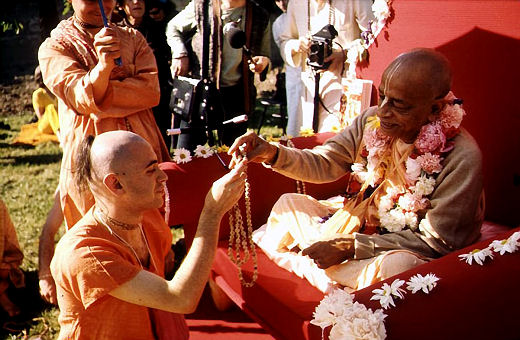
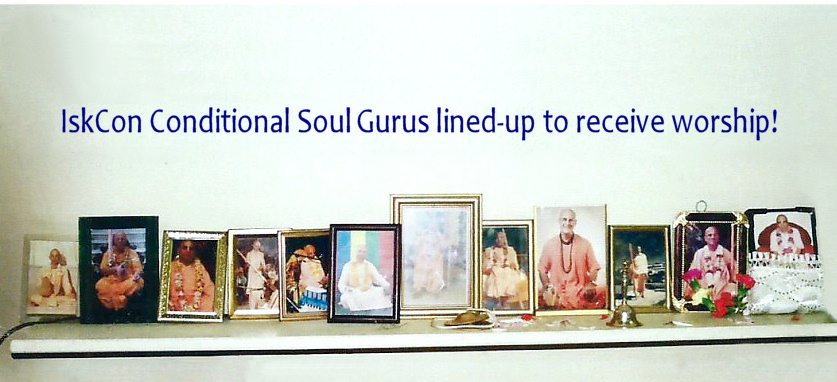




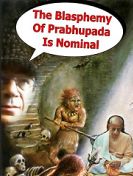
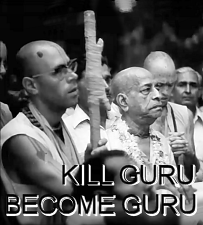
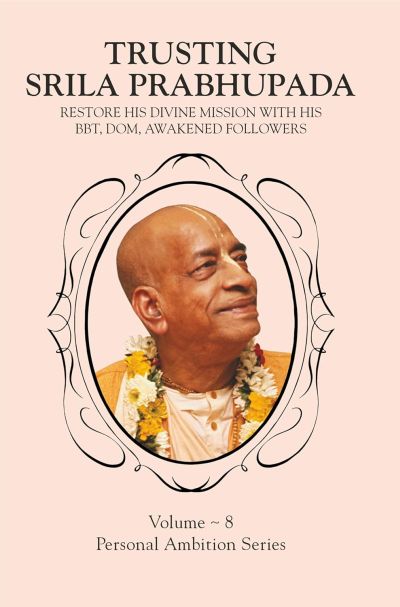
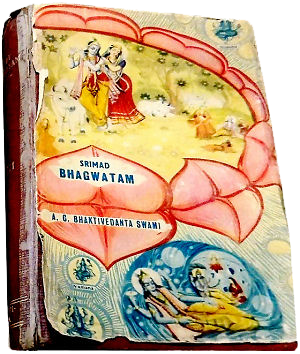
Pamho agtacbsp,i cant believe after 40 years still serving the guru hoaxes their brains become so dull that they can’t understand this simple truth and pretend to be still hare krsna ,is better to say who is your stink and blind donkey who fool all of you,they don’t believe to the law of karma otherwise they was not doing this nasty cheating anyway we can say that discrimination is a gift of god in this case because without discrimination one get cheated life after life,spiritual life is already difficult especially in this dark age but the guru hoaxes make it even more difficult and they declared to be maharaj then struggle with Maya now maharaj because are part of the problem or part of solution therefore there’s no need of taking another position then you are part of the problem and be servant das das anudasa we are part of the solution but to take another position without any qualification is very dangerous because the business of a real devotee is in the spiritual sky but the mudha like all the illegal guru hoaxes are doing it here and although they are swearing they can’t understand that the business is in the wrong place with the wrong people.anyway time will tell what strange destination they will get by taking the position of someone else,so who is your guru?is better to say SRILA PRABHUPADA because we don’t see someone else more qualified then our guru maharaj in all respect agtacbsp ys haribol